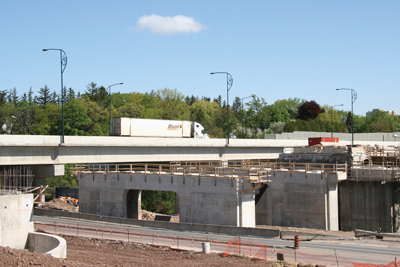
Features
Columns
Education
The next great Canadian infrastructure boom
June 11, 2009 By Rob Bradford
After decades of complacency by governments at all levels, there are growing signs that this nation’s second great infrastructure boom is upon us. Whether it will be a boom of historic nation-building proportions like the first one has yet to be seen, but the opportunity exists right now for Canada to rebuild and reposition its public core infrastructure to meet the social and economic challenges of the 21st century.
After decades of complacency by governments at all levels, there are growing signs that this nation’s second great infrastructure boom is upon us.

|
Whether it will be a boom of historic nation-building proportions like the first one has yet to be seen, but the opportunity exists right now for Canada to rebuild and reposition its public core infrastructure to meet the social and economic challenges of the 21st century.
In the 1950’s and 60’s Canada built the public infrastructure components that would fuel economic growth for the last half of the 20th century. Highways were built to carry traffic that wouldn’t be there for another 20 years. Sewers and watermains were installed to service what would become suburban sprawl over the coming decades. Massive hydroelectric and nuclear power developments would support future production of the manufacturing, mining and other key industries. It was a time for mega projects like the St. Lawrence Seaway, James Bay and the Alaska Highway.
Starting in the 1970’s Canadians’ attentions turned to other things and for the next 30 years a world-class public infrastructure was neglected. Public investment showed a steadily decline, very little new capacity was added and the existing inventory was not maintained to standard. As the economy continued to thrive, the core infrastructure that underpins it struggled to keep up.
Only in the last few years have governments begun to acknowledge the inadequacy of public infrastructure to support Canada’s economic growth and social development into the future. Provincial governments have led the way with gradual increases in their infrastructure investments. Municipalities absolutely recognize the imperative, but are limited in their ability to access taxpayer dollars to address local infrastructure needs. And motivated by the current recession, the federal government has also started to show the kind of commitment that will be required multi-fold in the future as the country tries to catch up to decades of infrastructure neglect and also build for the future.
Infrastructure investment needed now
In 2009 there are two reasons that governments are finding new money for public infrastructure. The first is that there is no longer any choice. Too many bridges are collapsing, too many watermains are disintegrating after 100 years without replacement and too many people are wasting too much of their lives trying to get to work in cars or buses on crumbling roads and highways. Massive, sustained infrastructure investment is required in the coming decades to rehabilitate and replace the current public stock. As much or more is needed to build the infrastructure that will support economic growth in the next half century.
The second reason for the immediate focus on infrastructure is the recognition that public investment in capital assets is a good way to create jobs and provide stimulus for economic recovery. While this is proven strategy for quick infusions of government cash to stimulate the economy, the danger is that when the economy starts to uptick once again there will be a false sense of the job being done. As Canadian Construction Association president, Michael Atkinson, warned recently, there is a danger that infrastructure is getting its ‘15 minutes in the spotlight’ and after that governments will move on to other priorities.
Despite increasing public commitment, much more is needed to meet the challenge of repairing, renewing and expanding the nation’s core infrastructure assets. The latest federal budget commits $11 billion of new money over two years to municipal infrastructure as a recession management strategy. Ottawa is also finally sending a nominal percentage of the federal excise tax on gas to the municipalities.
Provincial governments have been raising their infrastructure budgets significantly year-over-year, sometimes by double-digit percentages. The numbers are enormous but still fall far short of projections of the cost of past neglect and future requirements. The Federation of Canadian Municipalities, for example, puts the current national infrastructure deficit at $60 billion and says another $60 billion is needed to build new infrastructure that is needed now.
Public policy over the next five years will determine whether the current infrastructure boom will be of epic proportions like the first one, or will make a noble attempt at reducing infrastructure deficits before falling back into patterns of neglect. There is a national highway system to be rebuilt. There are border crossings to expand to move Canadian goods south. There are Eastern and Western gateways to develop, power generation mega projects to engineer and landmark bridges to be built. In the new age of environmental enlightenment there are also opportunities to lead the world with infrastructure technologies that respect the air, the land and the water. With some timely vision, the infrastructure boom of the late 2000’s could rival the first for its national significance.
Rob Bradford is executive director of the Ontario Roadbuilders’ Association.
Print this page